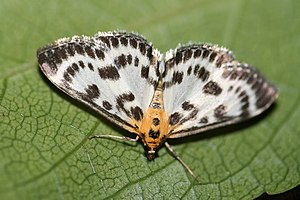Stinging nettle
| Stinging nettle | ||||||||||||
|---|---|---|---|---|---|---|---|---|---|---|---|---|

Nettle Nettle ( Anania hortulata ) |
||||||||||||
| Systematics | ||||||||||||
|
||||||||||||
| Scientific name | ||||||||||||
| Anania hortulata | ||||||||||||
| ( Linnaeus , 1758) |
The Anania Hortulata ( Anania hortulata , Syn. : Eurrhypara hortulata ) is a ( small ) butterfly from the family of Crambidae .
features
The moths reach a wingspan of up to 31 mm (or a fore wing length of 12 to 14 mm). The head and thorax are colored yellow ocher, the abdomen has black-gray and yellow bands. The feelers are simple. The basic color of the wings is white or silver-white with a double row of egg-shaped, brownish to black-gray spots along the dark-colored hemline. In the middle of the forewing there is another brownish spot, in the root field there are several brownish spots.
The squat caterpillars are yellowish or green and lightly hairy. Your head capsule is black.
The doll is dark red-brown. It is finely granulated and wrinkled in some places. The Kremaster has hook-like bristles of about the same length.
Geographical distribution and habitat
The species is widespread throughout Europe with the exception of the polar region and is also extremely common in suitable habitats. Outside of Europe it occurs in Asia Minor and through Siberia to the Russian Far East (Lower Amur Region). It has now also been abducted to North America.
The nettle eater lives in fresh and semi-humid habitats, such as B. Gardens, forest edges and floodplains, preferably where the main food plants nettle grow.
Way of life
The nettle eater makes one generation a year; the crepuscular and nocturnal moths fly from May to mid-September. During the day, they can be found mainly in bushes and on nettles, but they can easily be scared away from the vegetation. At night they come to artificial light sources. The caterpillars can be found from August to September and after wintering until May. They live in the coiled leaves of their food plants. As food plants are mentioned:
Ian Kimber also mentions:
- Black nettles ( Ballota )
- Winches ( Convolvulus ), and
- Bindweed ( Calystegia )
The caterpillars overwinter in a cocoon , either in the fallen leaves or in a stem, and pupate in the overwintering cocoon in the spring without the caterpillars eating again.
Systematics and taxonomy
The species was first scientifically described in 1761 by Carl von Linné under the name Phalaena hortulata Linnaeus, in 1761. A more recent synonym is Phalaena urticata Linnaeus, 1761. The species was later placed in the genus Eurrhypara and was known for a long time as Eurrhypara hortulata . The genus Eurrhypara Hübner, 1825 was synonymous with the genus Anania Hübner, 1823 by Patrice Leraut in 2005 , so that Anania hortulata is currently the valid name of this species.
swell
Individual evidence
- ↑ a b Carter (1984: p. 209)
- ↑ a b Hannemann (1964: p. 340)
- ↑ Jan Patočka: The pupae of the Central European borer (Lepidoptera: Pyraloidea, Pyralidae). Subfamilies Acentropinae, Odontiinae, Evergestinae and Pyraustinae. In: Linz biological contributions. 33rd volume, issue 1, Linz 2001, pp. 347-405 ( PDF on ZOBODAT ).
- ↑ Ayuna A. Shodotova: Pyralid Moths (Lepidoptera, Pyraloidea) of Buryatia: Family Pyraustidae. In: Entomological Review. 88 (5): 543-557, 2008 doi : 10.1134 / S0013873808030044 .
- ^ VV Dubatolov, AN Streltzov: New records of pyralid moths (Insecta, Lepidoptera, Pyraloidea) in the Lower Amur. In: Amurian zoological journal. II (1), 2010, pp. 57-60 ( PDF on eco.nsc.ru; Russian).
- ↑ Slamka (1997: 22)
- ↑ a b UK moths website by Ian Kimber
- ↑ Patrice JA Leraut: Contribution à l'étude de quelques genres et espèces de Pyraustinae (Lepidoptera: Crambidae). Nouvelle Revue d'Entomologie, 22 (2): 123-139, Paris 2005.
literature
- David J. Carter: Pest Lepidoptera of Europe with special references to the British Isles. Dr. W. Junk Publishers, Dordrecht 1984, ISBN 90-6193-504-0 , 431 pages.
- Hans-Joachim Hannemann: Small butterflies or Microlepidoptera II. The curlers (sl) (Cochylidae and Carposinidae). The moth-like (Pyraloidea). In: Friedrich Dahl: The animal world of Germany and the adjacent parts of the sea according to their characteristics and their way of life. Part 50, VEB Gustav Fischer Verlag, Jena 1964.
- Frantisek Slamka: The Common Moth (Pyraloidea) of Central Europe: Determination - Distribution - Flight area - Way of life of the caterpillars . 2nd partially revised edition, Bratislava 1997, ISBN 8-096-75402-5 .
- Andreas Tränkner, Houhun Li, Matthias Nuss: On the systematics of Anania Hübner, 1823 (Pyraloidea: Crambidae: Pyraustinae). Nota lepidopterologica. 32 (1): 63-80, 2009 ( PDF on soceurlep.eu).
Web links
- www.lepiforum.de Taxonomy and photos
- www.schmetterling-raupe.de
- Ian Kimber: Guide to the moths of Great Britain and Ireland (English)
- Moths and Butterflies of Europe and North Africa (English)
- Anania hortulata at Fauna Europaea
- GloBIZ Global Information System Common Moth


